Steve Cox | December 23, 2017
INTERVIEW
Zach Osborne |2017 AMA 250cc National MX Champion and AMA 250cc Eastern Regional Supercross Champion
In his 12th year of professional racing, Zach Osborne takes that last step from contender to champion.
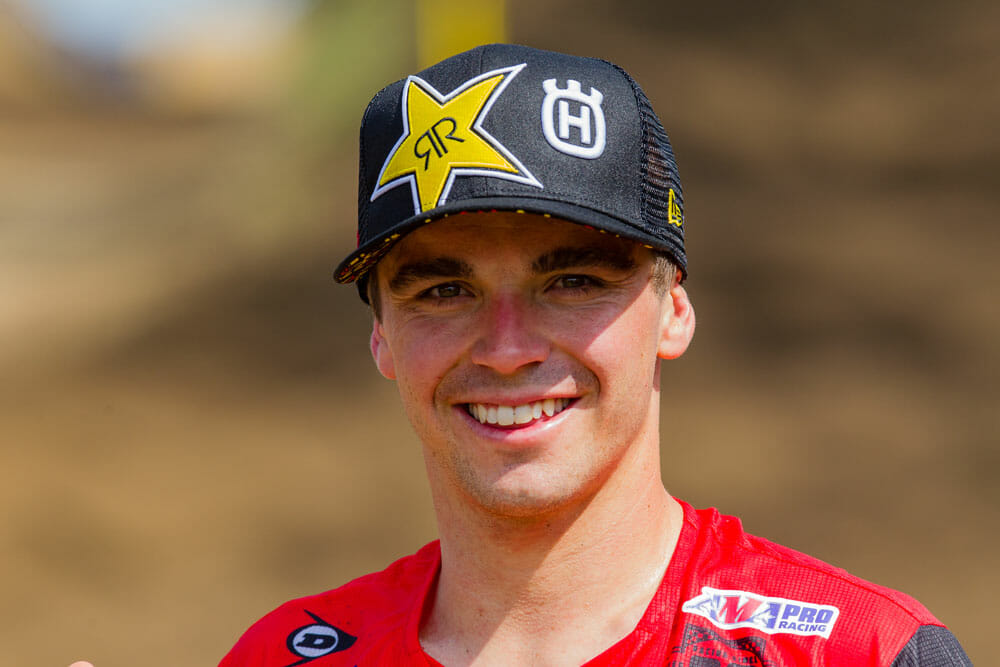
In the “what have you done for me lately” sport of professional motocross and supercross, it’s rare for racers to get more than one chance to “make it.” The list of racers with massive talent coming out of the amateur ranks that “washed out” early in their pro careers is much longer than the list of racers who ever won anything at all.
When Zach Osborne came out of the amateurs in 2006, he was the hottest commodity around, but that didn’t even last until the end of the year before he was written off following a horrendous performance at the Budds Creek National, where he led most of a moto before fading to 18th.
Instead of giving up after the American teams lost interest, he went to Europe and raced for a few years, then returned to the U.S., where he was always a solid contender for top-fives and podiums, but not really for wins or championships.
But things changed dramatically in 2017.
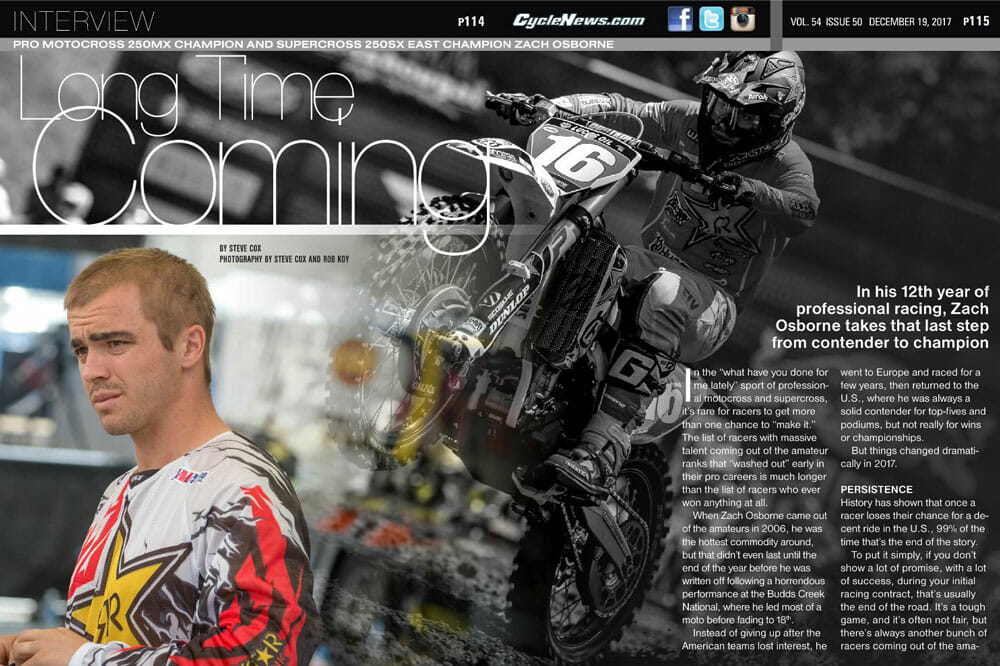
Click here to read this in the Cycle News Digital Edition Magazine.
Photography by Steve Cox and Rob Koy
Persistence
History has shown that once a racer loses their chance for a decent ride in the U.S., 99-percent of the time, that’s the end of the story.
To put it simply, if you don’t show a lot of promise, with a lot of success, during your initial racing contract, that’s usually the end of the road. It’s a tough game, and it’s often not fair, but there’s always another bunch of racers coming out of the amateurs to take your place.
When things dried up for Osborne, he headed to Europe. After a half-decade or so, with some success (podiums, but no wins), Osborne found his way back to the States for the opening four rounds of Supercross. On a Yamaha built by his GP team, Osborne went 9-6-3-3 in the first four rounds of the series and sat third in points.
This piqued the interest of the GEICO Honda team, where Osborne raced the next two years before switching to the Rockstar Energy Husqvarna team in 2015. During this period of time, podiums were the new normal, but wins just weren’t happening, and after 10 years of racing, if you haven’t started winning yet, normally it’s just not going to happen. But Zach Osborne isn’t normal.
This year, Osborne won his first Supercross, followed by the championship, and then did likewise outdoors, winning his second-ever event at round one, and then taking the title. The path to elite status was arduous and daunting, but Osborne took it as it came, and his persistence paid off big-time in 2017.
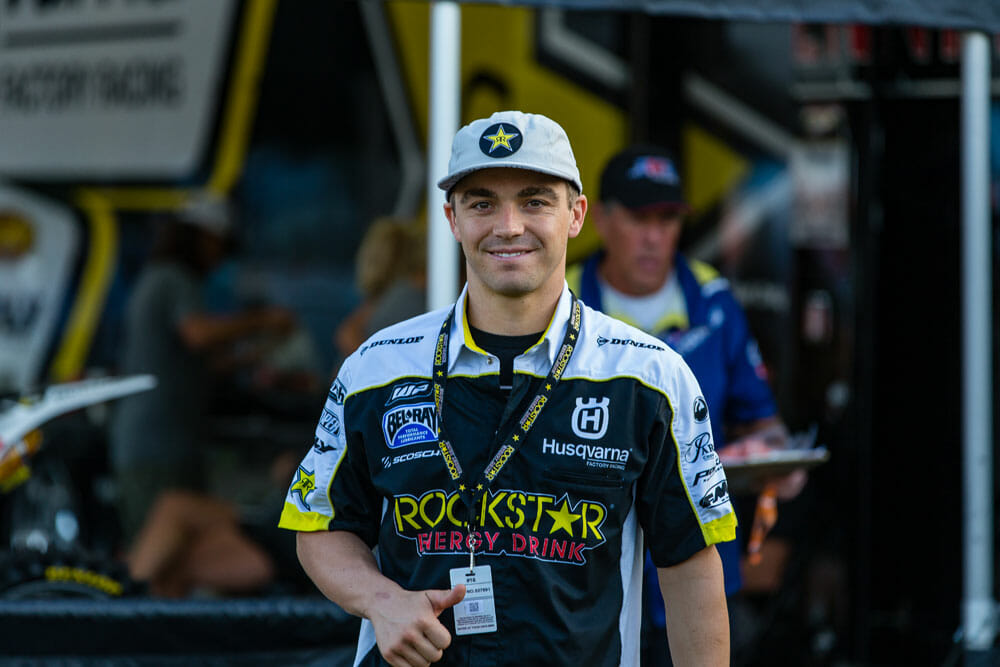
“Opportunity-wise, I’ve always kind of been there and been solid,” Osborne said. “Mainly, I’ve been easy to deal with I think from a team aspect, mostly. So I think that was one thing. I’ve always been there for podiums and top fives and that kind of thing pretty much regularly, I would say. But just the last couple years I’ve kind of found an obsession in just becoming the best I can possibly be and seeing what I can do with it, really. Before it was more like I was just—I don’t know. I really can’t explain it. It was like I was kind of just trying to make a living and do the best I can and just kind of go with what comes at me. The last two or three years I’ve been kind of charging it head-on. I feel like that’s been the biggest change or difference for me from a personal standpoint, for sure.”
Confidence built over the last few years and really started to grow coming into 2017 as Osborne’s training and riding at the Baker’s Factory with Husky/KTM teammates Ryan Dungey, Marvin Musquin, and Jason Anderson really got him into the proper head space for winning.
“I’m not sure that there’s a ‘knowing you can’ in terms of winning,” Osborne said. “Even as I sit here today as a two-time champion, I’m already nervous about whether I can do it again for next year. I think even at the tiptop there’s not a point where I rolled up this year and I was like, ‘I’m definitely going to win this moto.’ It’s motocross and there are so, so, so many factors and things that can happen that are out of your control. It’s just a very different sport as a whole compared to a lot of other sports out there.”
But while he rejects the idea of knowing he can—which may serve just as much as self-motivation as anything—he definitely knows belief in himself is a necessary part of a winning formula.

“Oh yeah, I believe I can, but it’s not like I’m sitting at home on the couch chilling waiting for the season to come,” Osborne said. “I’m already starting to prepare again and nervous. Trying to just be my best and make it happen all over again. I feel like almost knowing you can win would be a bad thing, because you’re going to be almost a little bit complacent or just not quite firing on all cylinders because you feel ‘above it’ or whatever. For me, I try to just stay on the ground and keep working.”
Many racers see the preparation—the training, testing, practicing, etc.—as a necessary evil on the way to the end goal of winning, but Osborne actually enjoys the preparation as much as he enjoys success.
“Winning is definitely fun, and money is nice and everything, but I enjoy the process,” Osborne says. “I’m a pretty one-to-one guy when it comes to work, just my body type and my natural ability leads me to be vulnerable to missing things. So, for me it’s just I know that if I do the work during the week it’s going to be easier and better on the weekend.”
In other words, as with many racers in the past—including Dungey, Ryan Villopoto, Ricky Carmichael, and many more—a big part of the benefit of training really hard isn’t even about physical conditioning, but rather the mental advantage that comes with believing you’re in the best shape of anyone lined up on the gate with you.
“That was me down to the ground this year,” Osborne said. “It came very easy on the weekends. This year’s definitely the most I’ve ever enjoyed the weekends, even if it wasn’t a winning weekend. Most of the weekends I really did enjoy, other than maybe Detroit where I had a DNF, which was completely out of my control for the most part.”

Setting The Stage
It’s that race in Detroit that set the stage for one of the greatest single performances in supercross racing. Osborne was in control of the championship going into Detroit, but as he entered the first turn in the main event, Jordon Smith came across stealing the holeshot from the outside and clipped Osborne’s front wheel. Osborne not only went down, but his front wheel was destroyed, leading to a pit stop and an 18th-place finish. He went from leading the points by nine to trailing by 10.
“I had won three races out of the five or six that we had done at that point,” Osborne said. “I had the red plate and just like that, none of that mattered. It was all gone. The whole championship looked to be in pretty serious jeopardy at that point just because it’s a short series and I think I scored three or four points that night, and all my competitors did quite well. So that was definitely a pivotal moment, but like I said, it’s something that’s completely out of my control no matter how hard I work or what I do. I can’t control the other 40 people on the starting gate, or 20 in that case. That’s something that’s just kind of super unique about our sport.”
There were only three rounds left, and Osborne went 3-1 in the nest two, which landed him tied for second in points with Joey Savatgy, a single point behind new points leader Smith.
It would all come down to the East/West Shootout in Las Vegas, and that race will end up going down in history as a contender for the greatest performance in the history of Supercross.
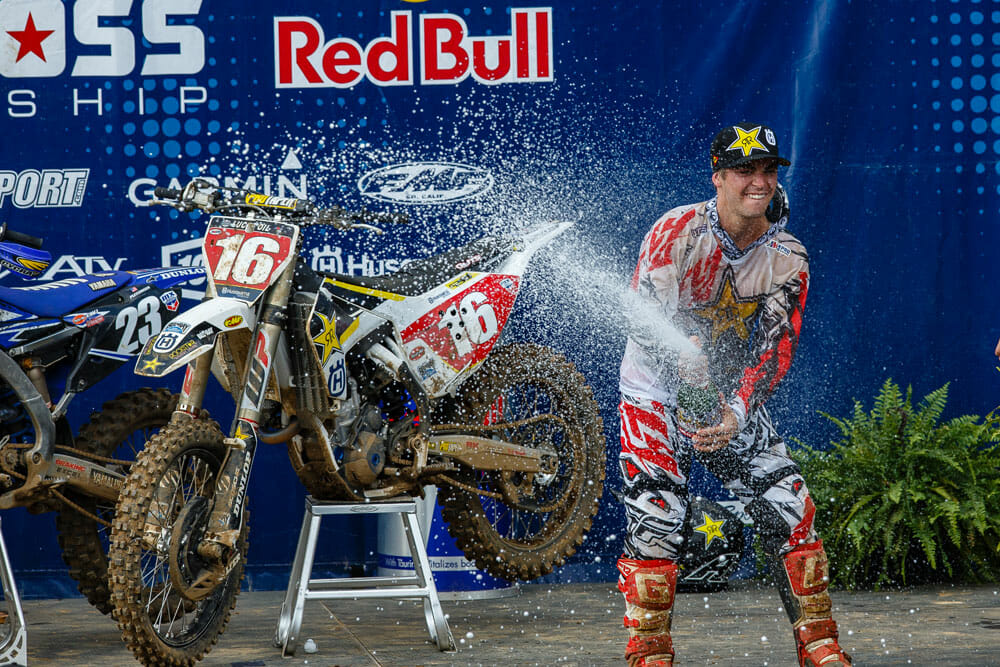
One To Remember
The East/West Shootout combines racers from both coasts, and it also pays points based on actual finishing position, so even if a racer on the East were to finish 10th, it’s conceivable they could still “win” in terms of beating everyone in their own championship points chase. Trailing by one point behind Smith, and tied with Savatgy for second in points, things looked absolutely dire for Osborne at the start of the East/West Shootout in Las Vegas. Osborne went down in the first turn and was delayed in returning to the fray by the others in the crash with him. Meanwhile, Savatgy started second, and Smith was right behind him in third.
“When I went down it pretty much was like, ‘Well, that sucks,’” Osborne said. “There goes what could have been.”
While Osborne just tried to get back up to speed, Smith looked like a man on a mission, dispatching of Savatgy (who had some mistakes of his own in the opening laps), but then Smith went down really, really hard on the fastest part of the track and was forced out of the race. This left the championship in Savatgy’s hands as he ran fourth.
“I have a pretty good awareness of what’s going on around me the whole time in the lead or wherever I’m at,” Osborne said. “I’m watching everything else that’s going on as well, because I just feel like that’s kind of the responsibility that you have as a racer. You need to know everything. The race kept going and I could see Joey [Savatgy]. We were kind of halfway through and I was like, ‘You’re going to be close, but you’re not going to get there. You’re not quite going to make it.’ Even with two laps to go, I still had to pass three guys to get to him. Then even when we came back in the stadium on the last lap, I still had to pass Mellross to get to him. I was just like, ‘I’m going to be really close but it’s going to be what could have been’ at the end. It’s history now.’”
While Osborne was slicing his way through the field, a few laps from the end of the race, the fans caught on that there was a chance. As he inched closer and closer to Savatgy, the crowd sensed it and one could feel it like electricity in the air. As Osborne made the pass on Mellross, hair stood up on the crowd’s arms.
“Trust me, I could feel it,” Osborne said. “I could feel the crowd kind of building with me. It just kept getting closer and closer. I just felt like at some point he was going to see me and be like, ‘I need to wake it up for two laps and win this championship.’”
But Savatgy didn’t. As Osborne drove through the whoops for the last time and dived to the inside of Savatgy in the second-to-last corner of the race, colliding with his rival and sending him to the ground, the crowd erupted. As Osborne crossed the finish line and began to celebrate, the whole crowd stood in awe, staring at each other as if to confirm that they indeed just witness what they witnessed. It was one of the greatest moments in Supercross history, and it came from one of the most unlikely champions in history as well.
“It was a shocker to me, the whole time,” Osborne said. “I’ve watched the race start-to-finish probably 50 times, bits and pieces more than that. It’s an insane race. So many people have come up to me and said this was the greatest race ever in supercross, and I’m like, ‘But I got seventh!’ I’m not trying to downplay it in any way, but it’s bizarre to me to hear that after the trials and tribulations of my early career and stuff. Just to kind of be that guy now is pretty surreal, really, still.”
 The 2017 250SX East Supercross Championship wasn’t decided until the last lap of the last race. Osborne didn’t win the race, but he won the Championship.
The 2017 250SX East Supercross Championship wasn’t decided until the last lap of the last race. Osborne didn’t win the race, but he won the Championship.
Controversy Ensues
Yet, despite the amazing race and the astounding result, protests came flying into the AMA truck from Kawasaki and Savatgy’s Pro Circuit team. As if it had never occurred to the folks at Kawasaki that if they took Osborne’s title through a protest over “rough riding” it might damage their cause more than help it, they protested Osborne’s pass. Even worse, the AMA ended up fining Osborne for it, even though there’s no way anybody, anywhere could find a single former champ who would’ve not taken that shot in that turn if they were in Osborne’s position.
At a pivotal moment in the sport, off of perhaps one of the greatest single performance in history, the AMA tainted it with a fine just to placate the folks who happened to end up on the losing side this time.
“I understand that emotions were high and there were a lot of pissed off people about the pass or whatever,” Osborne said. “It was a tough pass, but it’s for so much more than just that position. It’s for a championship, and glory, and even financially, and the years to come. Even Joey, he’s admitted that in that situation he would have done exactly the same. It’s a tough racing call. I had already had the other run-in with Adam [Cianciarulo, Savatgy’s teammate] during the season, which also was a little bit of a bummer. Like I said, it’s just a tough call, flat out.”
Osborne was worried the AMA would take his title.
“When I went in there, I was pretty nervous as to what they were going to do,” Osborne said. “So when they decided to fine me, even though I still didn’t think it was right, I was just happy they didn’t take my championship, so I just got out of there.”
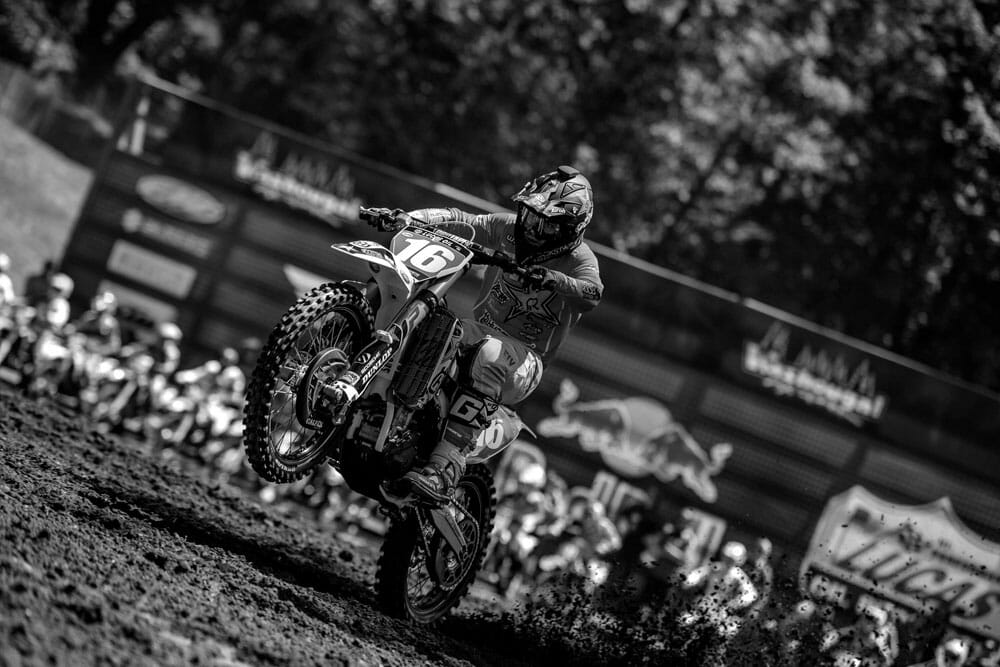
Backing It Up Outdoors
With all of that behind him, Osborne was an odds-on favorite to win outdoors. Carrying the momentum from the biggest moment in his career, and possibly ever, along with his fitness from working at the Baker’s Factory, Osborne set out on a mission, going 1-1 at the season opener at Hangtown. Interestingly, he didn’t get another 1-1 during the entire championship until the final round in Indiana, after he had already sewn up the title.
“The first round and the last round were like pretty much kind of dream situation,” Osborne said. “Good starts at the front, kind of battle for a little bit, and then go away. The last round especially was really good. I was super comfortable on the track and just got two really good starts. But during the middle of the season, my starts were mediocre at best. They were kind of midpack. I got a lot of seconds, thirds, fourths, but I felt like I fought so hard for those positions. Washougal I fell in the second corner and got up and got fourth in a moto. That was definitely the hardest moto I had all year just because I just felt like my heart rate was through the roof. I actually threw up after the moto because I was just so exhausted. It was just a tough day. There were a lot of Saturdays where I was like, ‘Man, that was freaking tough. I really don’t want to repeat this “bad starts” deal anymore.’ But I did. That just continued week-in and week-out. For the last round, we changed some stuff with my starts, with a little bit more RPMs, and that made things a lot better. I don’t know how we got away from that during the season, but we did. I definitely wish I had those first- and last-round starts the whole year. I think it would have been a heck of a lot easier on me.”
But sometimes things just seem destined to happen despite circumstances. At Millville, Osborne’s bike began to smoke just past halfway in the first moto, then stopped smoking (which is often the sign that it’s about to die), but he finished eighth anyway.
“There were some pivotal moments where it could have really gone either way,” Osborne said. “Like the day that I was supposed to wrap up the championship at Budds Creek there was a big first-turn crash. I was in there. There were a couple deals where it was just like kind of on edge, but I kind of got myself a comfortable gap. I had a really good gap in points from the first round and the second round, and then I didn’t do so well in Colorado because I was really sick. Then I think they had it down to like nine points before High Point. Then I just went on a little bit of a tear and built up my points lead to where even in the bad motos I didn’t have so, so much to worry about and I could just kind of manage the points lead from out front.”
And, in the end, that made all the difference. Zero titles in 11 years as a pro, then two in one year.
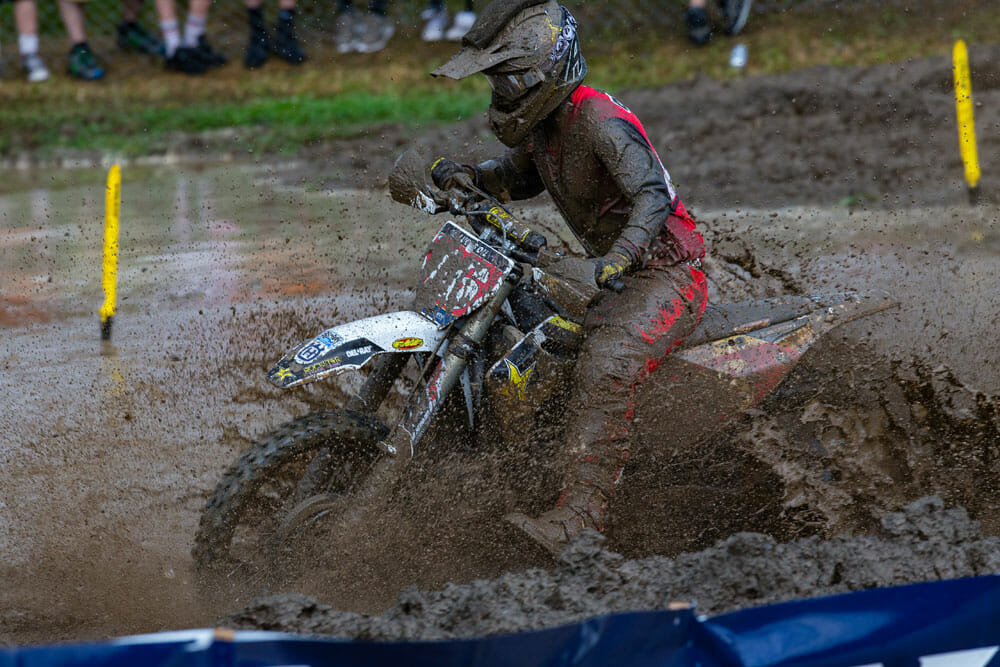 To be a true champion, you have to weather days like these. And that’s exactly what Osborne did.
To be a true champion, you have to weather days like these. And that’s exactly what Osborne did.
Perspective Matters
Rewinding to that fateful day with the worst fade in the history of motocross racing at Budds Creek in 2006, there’s no way anybody would believe that Zach Osborne would end up a champion in that same series 11 years later.
“Even more so five years after that, I still would have called bullshit [on that idea] too, because there’s been times where I felt so, so far from where I am today,” Osborne said. “I can’t really explain it. Aldon [Baker] definitely helped me mentally. Riding with those guys every day made me a little bit, I would say, race-toughened, race-hardened. Those are just the only two things I can really attribute my huge step from last year to this year to. There’s been a lot of people and a lot of scenarios and just a lot of things to bring me from that race in 2006 to this day in 2017.”
This kind of perspective gives Osborne a toughness that his competitors lack, and the differences in life experience between the 28-year-old family-man and his much younger competition only make the difference in perspective more stark.
“When we first had our baby, Emory, she’s three, it kind of lit a little bit of a new fire that I didn’t have before, too,” Osborne said. “Kind of the rubber met the road a little bit harder than ever before for me. That definitely gave me a lot of perspective and just different ways of seeing things and looking at things.”
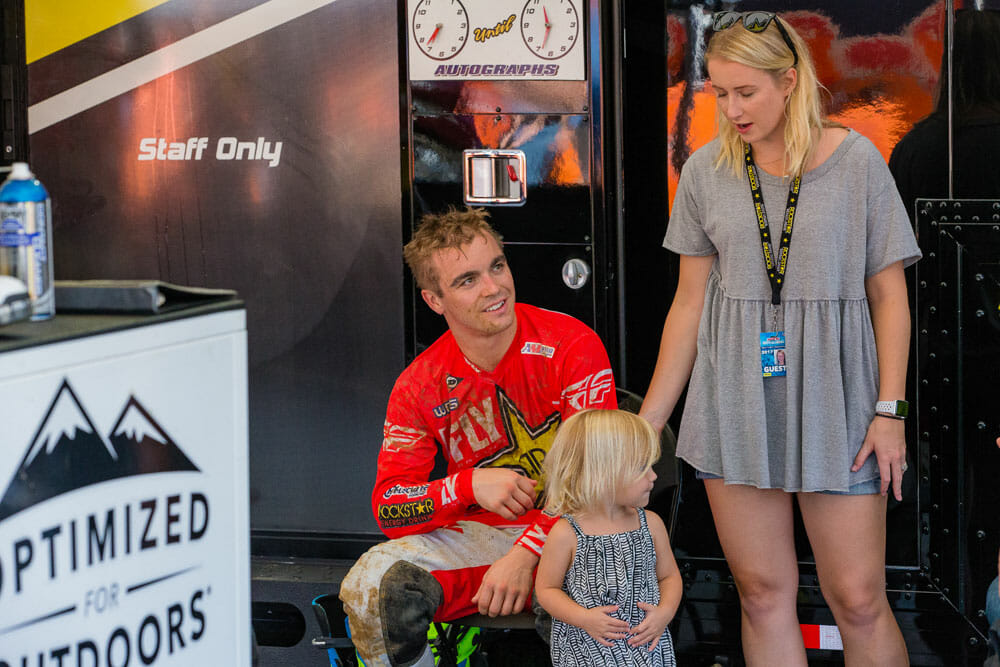
But it got even heavier than that this year.
“Halfway through outdoors, actually the week before Millville, which was close to a disaster, my wife had a miscarriage,” Osborne said. “That was even again a step back to look at things. Before that time, the championship seemed so, so important and then that happened and it was like, it really doesn’t matter that much. It’s dirt bike racing. It’s a small portion of hopefully a long life. I just kind of see it all a little bit differently than everyone else, I guess. I’m not bummed about how I see things, to be honest. I like the way that I see things and the way that I do things. It’s a little bit unorthodox or different, but also my career and path and approach have always been that way. It’s just what works for me and I’m going to continue to do it.”
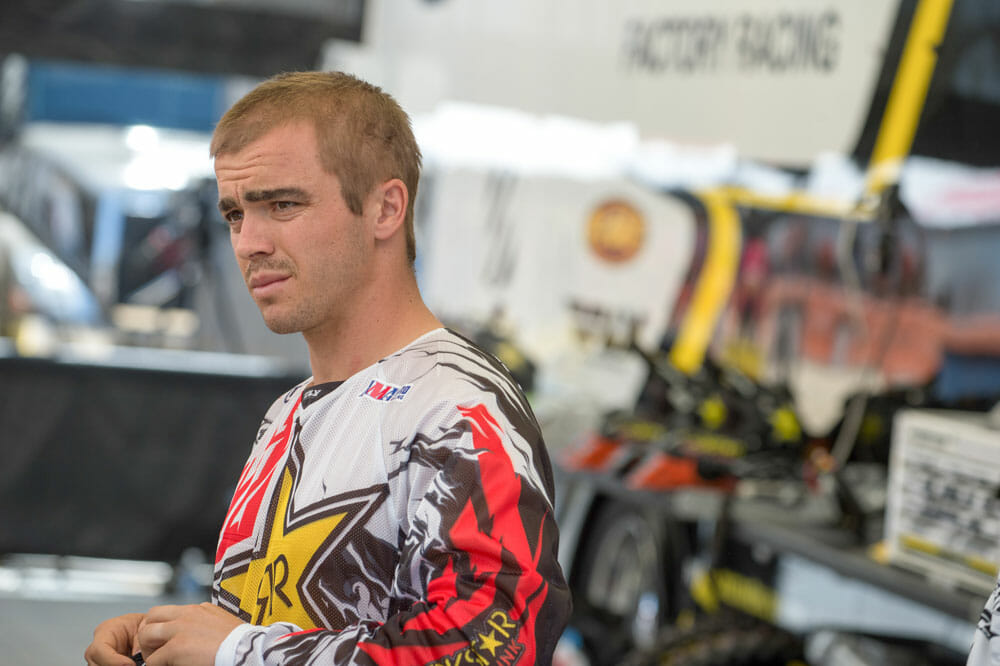
Where To From Here
In 2018, Osborne is going to carry what works for him through a title defense in the 250cc East SX Series, and then the finale in Las Vegas will mark his final race in the 250cc class.
“I’m going to do 250 Supercross and defend my East Coast Championship and then the plan right now is to ride the 450 outdoors,” Osborne said.
Osborne has raced a 450 before, as part of Team Puerto Rico at the 2008 Motocross of Nations in England. He was good even back then, finishing second in the Open-class qualifier and sixth place in the second MX2/Open moto. Michael Byrne and Timmy Ferry were eighth and ninth in that moto. Osborne can ride a 450, and he proved it a decade ago.
“It’s just the opportunity,” Osborne said. “As you saw with Marty [Martin Davalos] this year, he did really well outdoors; got a couple podiums and was a top-five-or-six guy, and there were no 450 opportunities for him [in 2018]. It’s not easy to get those rides. I’m grateful to have the opportunity for this year and into ’19 with Husqvarna to do 450s.”
If he keeps this up, if he doesn’t win 450cc titles right away, don’t worry; give him 12 years or so. He’ll win titles by 2030.CN